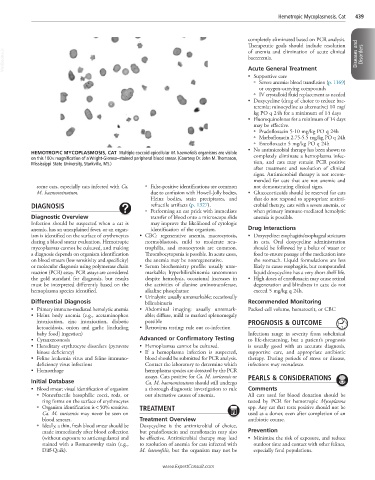Page 903 - Cote clinical veterinary advisor dogs and cats 4th
P. 903
Hemotropic Mycoplasmosis, Cat 439
completely eliminated based on PCR analysis.
Therapeutic goals should include resolution
VetBooks.ir bacteremia. Diseases and Disorders
of anemia and elimination of acute clinical
Acute General Treatment
• Supportive care
○ Severe anemia: blood transfusion (p. 1169)
or oxygen-carrying compounds
○ IV crystalloid fluid replacement as needed
• Doxycycline (drug of choice to reduce bac-
teremia; minocycline as alternative) 10 mg/
kg PO q 24h for a minimum of 14 days
• Fluoroquinolones for a minimum of 14 days
may be effective.
○ Pradofloxacin 5-10 mg/kg PO q 24h
○ Marbofloxacin 2.75-5.5 mg/kg PO q 24h
○ Enrofloxacin 5 mg/kg PO q 24h
• No antimicrobial therapy has been shown to
HEMOTROPIC MYCOPLASMOSIS, CAT Multiple coccoid epicellular M. haemofelis organisms are visible
on this 100× magnification of a Wright-Giemsa–stained peripheral blood smear. (Courtesy Dr. John M. Thomason, completely eliminate a hemoplasma infec-
Mississippi State University, Starkville, MS.) tion, and cats may remain PCR positive
after treatment and resolution of clinical
signs. Antimicrobial therapy is not recom-
mended for cats that are not anemic and
some cats, especially cats infected with Ca, ○ False-positive identifications are common not demonstrating clinical signs.
M. haemominutum. due to confusion with Howell-Jolly bodies, • Glucocorticoids should be reserved for cats
Heinz bodies, stain precipitates, and that do not respond to appropriate antimi-
DIAGNOSIS refractile artifacts (p. 1327). crobial therapy, cats with a severe anemia, or
○ Performing an ear prick with immediate when primary immune-mediated hemolytic
Diagnostic Overview transfer of blood onto a microscope slide anemia is possible.
Infection should be suspected when a cat is may improve the likelihood of cytologic
anemic, has an unexplained fever, or an organ- identification of the organism. Drug Interactions
ism is identified on the surface of erythrocytes • CBC: regenerative anemia, macrocytosis, • Doxycycline: esophagitis/esophageal strictures
during a blood smear evaluation. Hemotropic normoblastosis, mild to moderate neu- in cats. Oral doxycycline administration
mycoplasmas cannot be cultured, and making trophilia, and monocytosis are common. should be followed by a bolus of water or
a diagnosis depends on organism identification Thrombocytopenia is possible. In acute cases, food to ensure passage of the medication into
on blood smears (low sensitivity and specificity) the anemia may be nonregenerative. the stomach. Liquid formulations are less
or molecular diagnosis using polymerase chain • Serum biochemistry profile: usually unre- likely to cause esophagitis, but compounded
reaction (PCR) assay. PCR assays are considered markable; hyperbilirubinemia uncommon liquid doxycycline has a very short shelf life.
the gold standard for diagnosis, but results despite hemolysis, occasional increases in • High doses of enrofloxacin may cause retinal
must be interpreted differently based on the the activities of alanine aminotransferase, degeneration and blindness in cats; do not
hemoplasma species identified. alkaline phosphatase exceed 5 mg/kg q 24h.
• Urinalysis: usually unremarkable; occasionally
Differential Diagnosis bilirubinuria Recommended Monitoring
• Primary immune-mediated hemolytic anemia • Abdominal imaging: usually unremark- Packed cell volume, hematocrit, or CBC
• Heinz body anemia (e.g., acetaminophen able; diffuse, mild to marked splenomegaly
intoxication, zinc intoxication, diabetic possible PROGNOSIS & OUTCOME
ketoacidosis, onion and garlic [including • Retrovirus testing: rule out co-infection
baby food] ingestion) Infections range in severity from subclinical
• Cytauxzoonosis Advanced or Confirmatory Testing to life-threatening, but a patient’s prognosis
• Hereditary erythrocyte disorders (pyruvate • Hemoplasmas cannot be cultured. is usually good with an accurate diagnosis,
kinase deficiency) • If a hemoplasma infection is suspected, supportive care, and appropriate antibiotic
• Feline leukemia virus and feline immuno- blood should be submitted for PCR analysis. therapy. During periods of stress or disease,
deficiency virus infections Contact the laboratory to determine which infections may recrudesce.
• Hemorrhage hemoplasma species are detected by the PCR
assays. Cats positive for Ca. M. turicensis or PEARLS & CONSIDERATIONS
Initial Database Ca. M. haemominutum should still undergo
• Blood smear: visual identification of organism a thorough diagnostic investigation to rule Comments
○ Nonrefractile basophilic cocci, rods, or out alternative causes of anemia. All cats used for blood donation should be
ring forms on the surface of erythrocytes tested by PCR for hemotropic Mycoplasma
○ Organism identification is < 50% sensitive. TREATMENT spp. Any cat that tests positive should not be
Ca. M. turicensis may never be seen on used as a donor, even after completion of an
blood smears. Treatment Overview antibiotic course.
○ Ideally, a thin, fresh blood smear should be Doxycycline is the antimicrobial of choice,
made immediately after blood collection but pradofloxacin and enrofloxacin may also Prevention
(without exposure to anticoagulants) and be effective. Antimicrobial therapy may lead • Minimize the risk of exposure, and reduce
stained with a Romanowsky stain (e.g., to resolution of anemia for cats infected with outdoor time and contact with other felines,
Diff-Quik). M. haemofelis, but the organism may not be especially feral populations.
www.ExpertConsult.com

